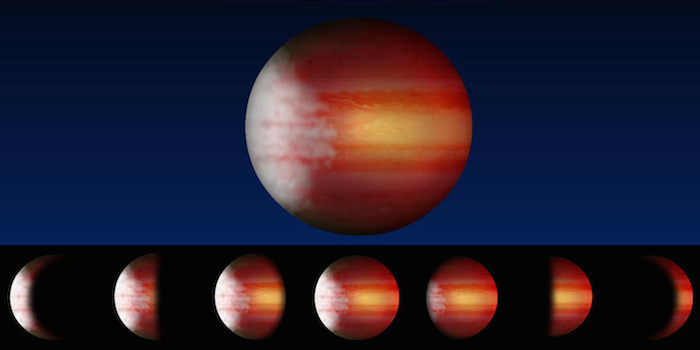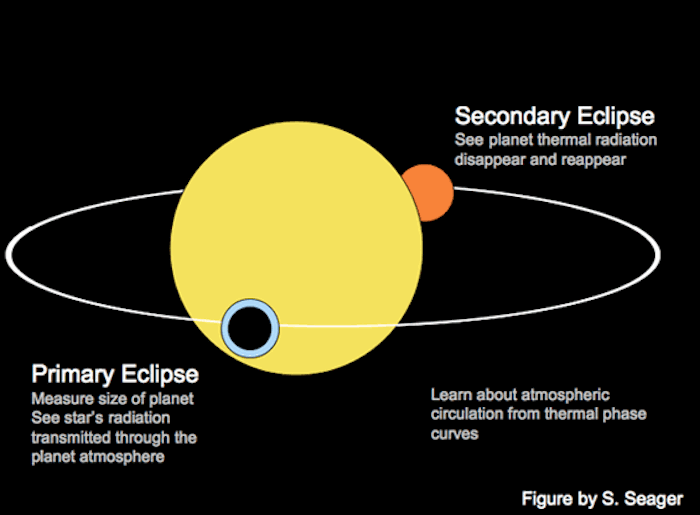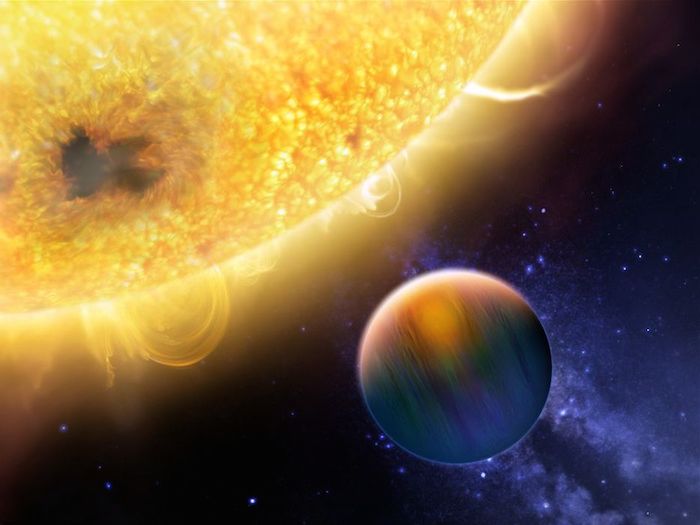.

An artist’s rendering of the possible weather and atmospheric circulation patterns on hot Jupiters. A new research by a team of astronomers that was based on data taken with NASA’s Kepler space telescope, studied the phase variations that occur as different portions of these planets are illuminated by their host stars as seen from our vantage point here on Earth, providing detailed insights the daily weather patterns on these distant alien worlds. Image Credit: Lisa Esteves/University of Toronto.
.
Daily weather forecasts are an integral part of modern life in every part of the world. Besides informing us for upcoming short-term weather conditions, these forecasts provide an essential understanding of the Earth’s overall climate over longer timescales. But what about the weather on extrasolar worlds? Out of the more than a thousand exoplanets that have been discovered to date, scientists only managed to create crude and rudimentary weather maps for just a handful of them. A new study, based on data from NASA’s Kepler space telescope and recently published by an international research team, comes to substantially increase our understanding of exoplanet atmospheres by presenting evidence of the daily weather cycles for more than a dozen planets around other stars.
Even though the first extrasolar world was discovered more than 20 years ago, the field of exoplanetary research has been completely transformed in the last five years specifically, with the launch of NASA’s Kepler space telescope in 2009. Staring constantly at a field in the sky containing 150,000 stars, Kepler has already discovered more than a thousand confirmed exoplanets as well as more than 4,500 exoplanet candidates to date with the use of the transit method, while also revealing the previously unimagined great abundance of exoplanets in the galaxy. As has already been detailed in previous AmericaSpace articles, the treasure trove of data already returned by Kepler has allowed astronomers to not only detect the presence of exoplanets but to start characterising them in detail as well, with the help of transit spectroscopy that has been conducted with other orbiting observatories like NASA’s Spitzer and Hubble space telescopes. More specifically, when an extrasolar planet happens to cross the face of its star as seen by our line of sight here on Earth, it causes a small dip in the star’s brightness which is proportional to the size of the exoplanet itself. If that planet also happens to have an atmosphere, the latter will absorb some of the star’s light in certain wavelengths during its transit, resulting in a wavelength-dependent transit depth, better known as a transmission spectrum. By studying this spectrum of the combined star-planet light, astronomers have extracted detailed information about the chemical composition, temperature, density, and overall dynamics for dozens of extrasolar worlds.
.

With the use of transit spectroscopy, astronomers can gain important information about a planet’s physical and chemical properties, as it passes in front and behind of its host star. Image Credit: Sara Seager
.
Another important tool in the study of exoplanets is the analysis of their phase curve. As is the case with the Moon and the inferior planets of the Solar System, Mercury and Venus, which display a full range of phases from new to full as seen from our vantage point, exoplanets can also exhibit phase variations during their orbital paths around their host stars. The analysis of these phase variations can yield great insights to the atmospheric and weather conditions on exoplanets through the study of their albedo (the amount of stellar light that is reflected from the exoplanet atmosphere back into space) and their flux ratios (the ratio of the planet’s reflected light to that emitted by its host star).
An international team of astronomers, led by Lisa Esteves, an exoplanet researcher and PhD student at the University of Toronto’s Department of Astronomy and Astrophysics in Canada, conducted just such a comprehensive analysis for a total of 14 “hot Jupiter”-type exoplanets, based on four years’ worth of data gathered by the Kepler space telescope. These types of planets are large and massive gas giants similar to Jupiter, that lie in orbits that are considerably closer to their host stars than that of Mercury in our own Solar System, resulting in scorching-hot temperatures at their cloud tops that can typically exceed 1,500 K. Being the first types of extrasolar worlds to be discovered in the 1990s, hot Jupiters have been studied extensively by astronomers through the years, who have managed to infer many details regarding their atmospheric chemical abundances as well as their possible internal compositions. By carefully analysing the light curves of the selected exoplanets in their study, Esteves’ team was able to now construct the first-ever detailed atmospheric circulation models, which in turn helped the researchers to provide weather reports for these types of extrasolar worlds. “We determined the weather on these alien worlds by measuring changes as the planets circle their host stars, and identifying the day-night cycle,” says Esteves. “We traced each of them going through a cycle of phases in which different portions of the planet are illuminated by its star, from fully lit to completely dark.”
One defining characteristic of hot Jupiters is that, due to their proximity to their host stars, they are tidally locked in their orbits similar to the way the Moon is tidally locked in its orbit around Earth, which means they present the same face toward their star as they revolve around it. Based on independent observations of hot Jupiters by other researchers, Esteves’ team hypothesize in their study that this type of orbital motion plays a defining role in the shaping of the weather and climate on these worlds. “Close-in planets, such as those in our sample, are expected to be tidally locked and will therefore rotate prograde, with the planet’s night-side moving in the direction of orbital motion,” write the researchers in their study which was published earlier this month in The Astrophysical Journal. “With this assumption, the planet’s evening-side will be visible during the first half of the orbit [before being eclipsed by the star as the planet moves behind it], while the morning-side will be more visible in the second (post-eclipse), regardless of on-sky orientation. Therefore, if atmospheric circulation moves in the direction of rotation, winds would transport energy from the substellar point [the location on an exoplanet over which its host star would appear to be in the zenith] towards the planet’s evening-side and then onwards towards the morning-side.”
This atmospheric circulation in effect results in a particular daily weather pattern, where the planet is covered with clouds in its night side due to the lower temperatures that dominate the latter relative to the day side, which then dissipate during the day from the extreme heat of the nearby star, thus leaving the local afternoons in sunshine and completely cloud-free. “As the winds continue to transport the clouds to the day side, they heat up and dissipate, leaving the afternoon sky cloud-free,” says Esteves. “These winds also push the hot air eastward from the meridian, where it is the middle of the day, resulting in higher temperatures in the afternoon.”
In addition, the researchers’ results suggested a possible link between the surface temperature and thermal emission of hot Jupiters and their atmospheric circulation patterns. More specifically, four of the examined exoplanets in the team’s study which had a comparatively lower temperature (below 2,300 K) exhibited an excess brightness in their day side—a typical characteristic for planets that were mostly illuminated by reflected star light. Yet two other exoplanets in the team’s sample, whose temperatures were above 2,700 K, exhibited an excess brightness that was dominant during the evening, resulting more from the planets’ own internal heat than from the reflected light from the host star. “By comparing the planets’ previously determined temperatures to the phase cycle measurements provided by Kepler, we found that the excess brightness on the morning side is most likely generated by reflected starlight,” explains Esteves. “The [cooler] four planets are not hot enough to generate this excess light through thermal emission. The excess light seen on the two very hot planets can be explained by thermal emission. A likely explanation is that on these two planets the winds are moving heat towards the evening side, resulting in the excess brightness.”
The study by Esteves’ team is the latest in the long line of research that has been conducted in recent years regarding the atmospheric dynamics on exoplanets, with the help of various space-based telescopes like Spitzer and Hubble. Yet, as fascinating as these latest findings are, they have nevertheless marked the limit of Kepler’s observing capabilities. “The detection of light from these planets hundreds to thousands of light years away is on its own remarkable,” comments Dr. Ernst de Mooij, a Research Fellow at Queen’s University Belfast in the UK and member of Esteves’ team. “But when we consider that phase cycle variations can be up to 100,000 times fainter than the host star, these detections become truly astonishing.”
More detailed views on the weather on distant alien worlds will have to wait the next generation of space-based observatories, like the James Webb Space Telescope, which are scheduled to launch within the next few years. “Upcoming space missions should reveal many more small planets around bright stars that will make great targets for detailed studies,” says Dr. Ray Jayawardhana, a professor of astrophysics at the York University in Toronto, Canada, and co-author of the recent study by Esteves’ team. “Someday soon we hope to be talking about weather reports for alien worlds not much bigger than Earth, and to be making comparisons with our home planet.”
Exoplanetary research has come a long way since the days of the first exoplanet discoveries more than 20 years ago. Given the great strides that have taken place in this exciting field of astronomical study in recent years, it is not unreasonable to assume that sometime in the not too distant future, detailed exoplanetary weather reports might be as common as new detections of exoplanets are today.
.

Hot Jupiters lie so close to their host stars that become tidally locked in their orbits, while always presenting the same face toward their star at any given time. This tidal locking plays a defining role in the shaping of weather on these alien worlds. Image Credit: NASA/ESA
Quelle: AS
4522 Views
